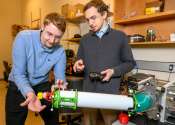Deciphering behavior algorithms used by ants and the internet
Engineers sometimes turn to nature for inspiration. Cold Spring Harbor Laboratory Associate Professor Saket Navlakha and research scientist Jonathan Suen have found that adjustment algorithms—the same feedback control process ...
Mar 1, 2022
0
186









